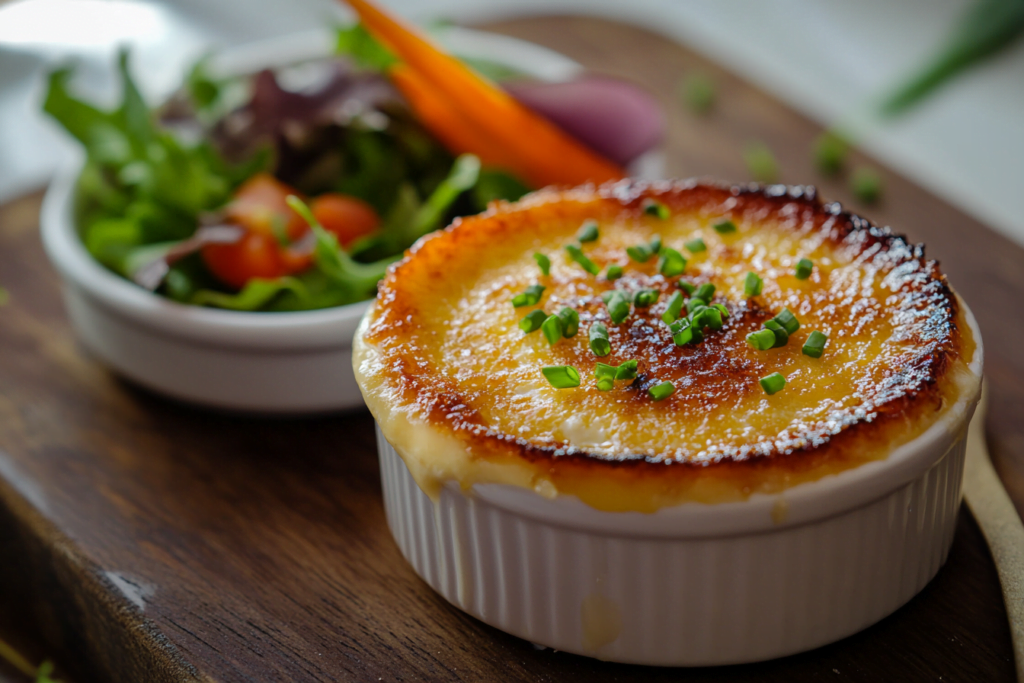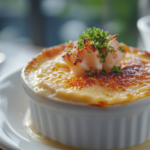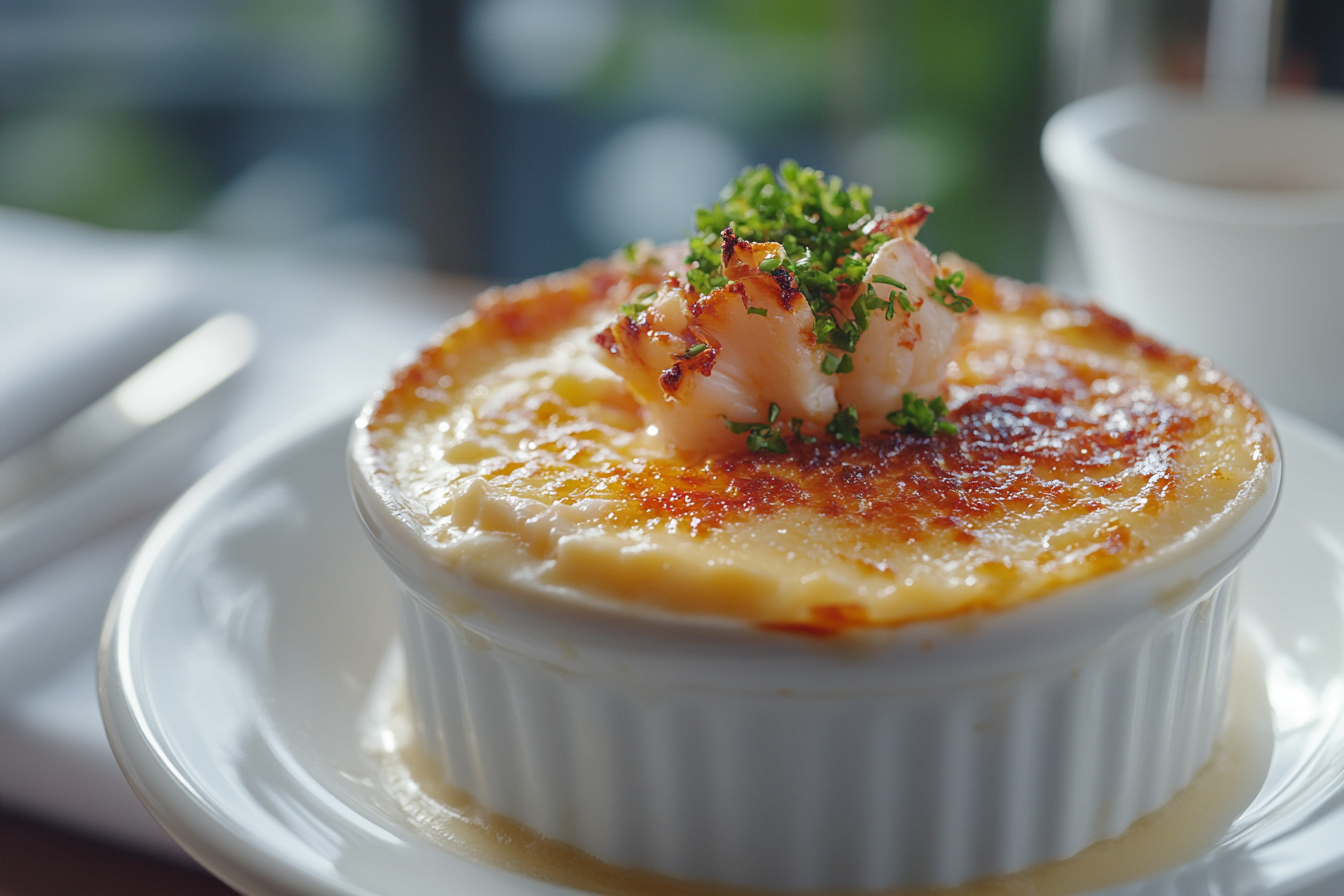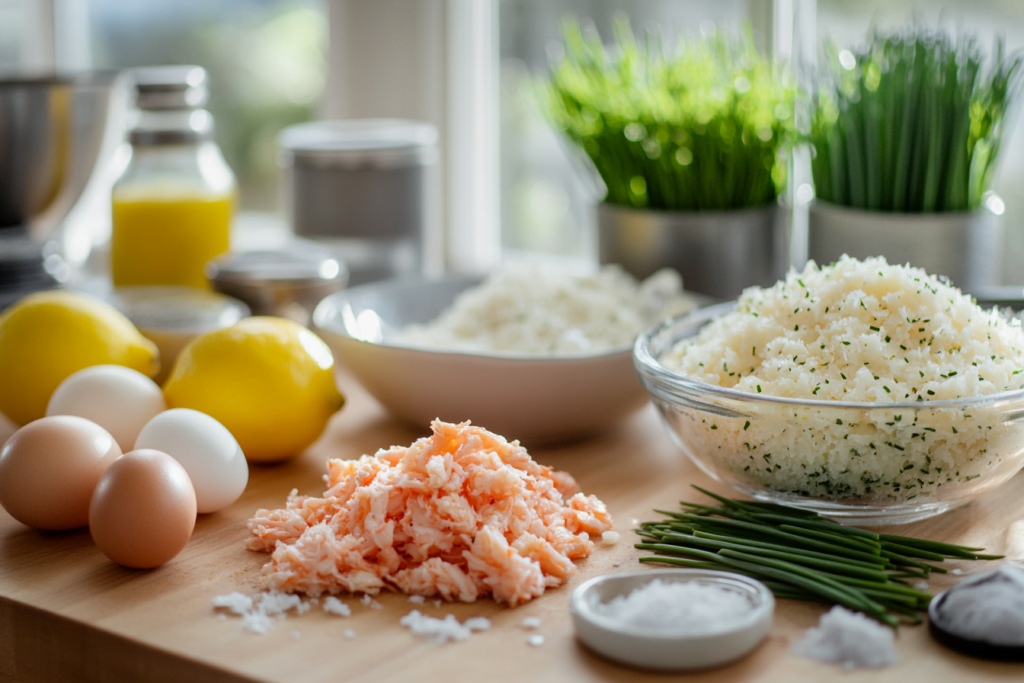A Culinary Experience: The Elegance and Comfort of Crab Brulee
Imagine the delicate crackle of caramelized sugar giving way to a luxuriously creamy custard, infused with the subtle sweetness of fresh crab—this Crab Brulee is not just a dish, but an experience that marries elegance with comfort. Whether you’re a seafood lover or a gourmet enthusiast, the Crab Brulee is a must-try recipe that brings together the best of both worlds. This dish takes the rich, velvety texture of a classic Crème Brûlée and elevates it with the savory, briny goodness of crab, creating a unique and sophisticated flavor profile that’s sure to impress.
The beauty of this recipe lies in its simplicity and the harmony of flavors. The creamy custard base, typically associated with sweet desserts, is transformed into a savory delight by incorporating fresh crabmeat and a touch of seasoning. The contrast between the creamy interior and the crisp caramelized sugar topping adds an extra layer of indulgence that is both unexpected and delightful. Whether you’re preparing this dish for a special occasion or simply to enjoy a gourmet meal at home, Crab Brulee is a recipe that will leave a lasting impression on your taste buds.
This dish is perfect for those who appreciate the art of cooking and are looking to expand their culinary repertoire with something both luxurious and approachable. With its rich flavors and elegant presentation, Crab Brulee is not just a meal—it’s an experience that brings people together, making every bite a memorable moment.
Ingredients for crab brulee
To create the perfect Crab Brulee, you’ll need a selection of high-quality ingredients that contribute to its rich, savory flavor. Here’s a comprehensive list of what you’ll need:
Main Ingredients:
- Fresh Crabmeat: 1 cup (preferably from a freshly cooked crab, lump or backfin meat for the best texture)
- Heavy Cream: 2 cups (for a rich, velvety custard)
- Egg Yolks: 4 large (providing the creamy base for the custard)
- Parmesan Cheese: 1/4 cup (finely grated, optional for added richness)
- Garlic: 2 cloves (minced, for a subtle aromatic flavor)
- Chives: 1 tablespoon (finely chopped, to add a fresh, mild onion-like flavor)
- Salt: 1/2 teaspoon (to taste, enhances the overall flavor)
- Black Pepper: 1/4 teaspoon (freshly ground, to taste, adds a gentle heat)
- Lemon Zest: 1 teaspoon (optional, for a bright, citrusy contrast)
For the Caramelized Topping:
- Granulated Sugar: 1/4 cup (white sugar for a classic, clear caramelization)
- Brown Sugar: 1/4 cup (for a deeper, more molasses-like flavor)
Optional Ingredients for Variations:
- Grated Gruyère Cheese: 1/4 cup (for a nuttier, more complex flavor)
- Fresh Herbs: such as thyme or tarragon (to add a unique herbal note)
- Smoked Paprika: a pinch (for a smoky depth)
- Truffle Oil: a few drops (for an indulgent, earthy aroma)
These ingredients work together to create a harmonious balance of flavors, where the richness of the cream and egg yolks complements the delicate sweetness of the crabmeat. The Parmesan cheese and garlic introduce a savory depth, while the chives add a refreshing contrast. The caramelized sugar topping, a hallmark of any crème brûlée, adds not only sweetness but also a textural contrast that enhances the overall eating experience.
Preparation Steps for Crab Brulee
Creating the perfect Crab Brulee requires careful attention to detail, but the process is straightforward and rewarding. Follow these step-by-step instructions to ensure a flawless dish every time:
1: Preheat the Oven and Prepare the Ramekins
- Preheat your oven to 300°F (150°C). This low temperature ensures that the custard cooks gently, resulting in a smooth, creamy texture.
- Prepare the ramekins by placing them in a deep baking dish. You’ll need enough space between them to pour water for a bain-marie (water bath), which helps to cook the custard evenly and prevents curdling.
2: Prepare the Custard Base
- Heat the cream: In a medium saucepan, combine the heavy cream and minced garlic. Heat over medium-low until the cream is hot but not boiling, allowing the garlic to infuse its flavor into the cream. Remove from heat and let it cool slightly.
- Whisk the egg yolks: In a large mixing bowl, whisk the egg yolks until they are pale and slightly thickened. Gradually add the salt, black pepper, and Parmesan cheese, whisking until fully incorporated.
- Combine the cream and yolk mixture: Slowly pour the warm cream into the egg yolk mixture, whisking constantly to avoid cooking the eggs. Continue whisking until the mixture is smooth and well combined.
3: Add the Crabmeat
- Fold in the crabmeat: Gently fold the fresh crabmeat into the custard base, ensuring that it is evenly distributed. Be careful not to break up the crab too much; you want to keep nice, chunky pieces for texture.
- Add lemon zest: If using, stir in the lemon zest for a hint of brightness that will cut through the richness of the dish.
4: Bake the Custards
- Fill the ramekins: Evenly divide the crab custard mixture among the prepared ramekins, filling each about three-quarters full.
- Create the bain-marie: Carefully pour hot water into the baking dish, around the ramekins, until it reaches halfway up the sides. This method ensures even cooking and prevents the custard from becoming too firm.
- Bake: Place the baking dish in the preheated oven and bake for 35-45 minutes, or until the custards are just set but still slightly wobbly in the center. Avoid overcooking, as this can lead to a grainy texture.
- Cool: Once baked, remove the ramekins from the water bath and let them cool to room temperature. After cooling, cover and refrigerate for at least 2 hours, or overnight, to allow the flavors to meld.
These preparation steps ensure that the custard base is silky and infused with the delicate flavor of crab, while the slow baking process helps to achieve the perfect texture. Next, we’ll discuss expert tips and tricks to take your Crab Brulee to the next level.
Expert Tips
Perfecting your Crab Brulee requires attention to detail, and a few insider tips can make all the difference. Here’s how to ensure your dish comes out flawlessly every time:
Achieving the Ideal Texture
- Low and Slow Cooking: The key to a smooth, creamy custard is gentle cooking. Baking at 300°F (150°C) and using a bain-marie ensures that the custard cooks evenly without curdling. Keep an eye on the custards towards the end of the cooking time; they should be set but still have a slight wobble in the center.
- Avoid Overmixing: When combining the cream with the egg yolks, whisk gently to avoid incorporating too much air into the mixture. Air bubbles can create an uneven texture in the final dish.
- Resting Time: After baking, allow the custards to cool completely before refrigerating. This resting period helps the flavors develop and gives the custard time to set properly.
Caramelizing the Sugar
- Choosing the Right Sugar: For a classic, crackly brûlée top, use granulated white sugar or a mix of white and brown sugar. White sugar creates a clear, crisp caramel, while brown sugar adds a richer, deeper flavor.
- Torch Technique: Use a kitchen torch to caramelize the sugar for the best control over the process. Hold the torch about 2 inches from the surface and move it in a circular motion to evenly melt the sugar. If you don’t have a torch, you can place the custards under a broiler, but be sure to watch them closely to avoid burning.
- Even Layering: Sprinkle an even layer of sugar over the top of each custard before caramelizing. Too much sugar can lead to a thick, chewy topping rather than the desired crispness.
Ingredient Substitutions and Additions
- Cheese Variations: While Parmesan adds a subtle nuttiness, you can experiment with other cheeses like Gruyère or even a touch of blue cheese for a bolder flavor.
- Herbal Notes: Fresh herbs like thyme or tarragon can be added to the custard base or used as a garnish for an herbal twist. These herbs pair beautifully with seafood and can bring a new dimension to the dish.
- Seafood Substitutes: If crab isn’t available, consider using lobster or shrimp for a similar flavor profile. These alternatives work well in the custard and provide a slightly different but equally luxurious taste.
Troubleshooting Common Issues
- Custard Too Runny: If your custard doesn’t set properly, it may have been undercooked. Be sure to check for that slight wobble in the center and extend the baking time if needed.
- Cracking Tops: If the custard top cracks after cooling, it may have been overcooked or cooled too quickly. To prevent this, always allow the custards to cool gradually and avoid placing them in a cold environment immediately after baking.
- Grainy Texture: This can happen if the custard base is overcooked or if the egg yolks are cooked too quickly when mixing with the hot cream. Always temper the eggs by adding the cream slowly and whisking constantly to prevent curdling.
By following these expert tips, you can refine your technique and ensure that your Crab Brulee is not only delicious but also visually stunning and texturally perfect.
Variations
One of the joys of cooking is the ability to customize recipes to suit your own tastes and dietary needs. Here are some creative variations of Crab Brulee that can add new dimensions to this already exquisite dish:
Dietary Adjustments
- Lighter Version: For a lighter version, you can replace the heavy cream with half-and-half or a combination of milk and cream. While this will produce a slightly less rich custard, it can be a good option for those watching their calorie intake.
- Dairy-Free Option: Use coconut cream or cashew cream in place of heavy cream to create a dairy-free Crab Brulee. These alternatives provide a rich texture while adding their own unique flavor profiles that complement the crab.
- Gluten-Free: The recipe is naturally gluten-free, making it an excellent choice for those with gluten sensitivities. Just be sure to check the labels on any packaged ingredients to confirm they are certified gluten-free.
Flavor Enhancements
- Spiced Up: Add a pinch of cayenne pepper or smoked paprika to the custard base for a hint of spice that pairs beautifully with the sweetness of the crab.
- Herb Infusion: Incorporate fresh herbs like dill, tarragon, or chervil into the custard for a fresh, aromatic twist. These herbs complement the seafood and add a light, green flavor.
- Citrus Notes: For a brighter flavor, incorporate lemon zest into the custard or as a garnish. The citrus helps to balance the richness of the dish and pairs wonderfully with the crab.
Alternative Seafood
- Lobster Brulee: Swap out the crab for lobster meat to create a decadent Lobster Brulee. The rich, sweet flavor of lobster pairs beautifully with the creamy custard and caramelized sugar topping.
- Shrimp Brulee: For a more affordable yet equally delicious option, try using shrimp instead of crab. Chop the shrimp into bite-sized pieces and fold them into the custard just as you would with the crab.
- Scallop Brulee: Another luxurious variation, using scallops adds a sweet, delicate flavor to the custard. Be sure to chop the scallops finely to ensure even distribution throughout the custard.
For Special Occasions
- Truffle Infusion: Add a few drops of truffle oil to the custard mixture for an earthy, luxurious touch that makes the dish truly special. This variation is perfect for a romantic dinner or a gourmet holiday meal.
- Cheese Lover’s Version: Incorporate a blend of cheeses, such as Gruyère, Parmesan, and a touch of blue cheese, to create a more complex, intensely flavored custard. This version is ideal for cheese enthusiasts looking for something out of the ordinary.
- Smoked Crab Brulee: For a unique twist, try using smoked crab meat. The smoky flavor adds depth and a new dimension to the dish, making it perfect for those who enjoy bold, savory flavors.
These variations allow you to personalize the Crab Brulee recipe to suit any occasion, dietary preference, or flavor preference. Whether you’re preparing it for a weeknight dinner or a special celebration, these ideas will help you make the dish your own.

Serving Suggestions for Crab Brulee
Once your Crab Brulee is perfectly prepared, the final step is presenting it in a way that not only highlights its flavors but also makes it visually appealing. Here are some creative serving suggestions to ensure your dish is as impressive to the eyes as it is to the palate:
Presentation Tips
- Individual Ramekins: Serve the Crab Brulee in individual ramekins for an elegant and personalized touch. The small size not only looks refined but also ensures that each guest gets the perfect portion.
- Garnishes: A sprinkle of fresh chives, a few microgreens, or a light dusting of smoked paprika can add a pop of color and flavor. A thin slice of lemon or a small sprig of dill placed on the side of the ramekin adds a fresh, vibrant contrast.
- Serving on a Slate or Wooden Board: Present the ramekins on a slate or wooden board for a rustic, yet chic, look. This method also makes it easy to serve multiple guests at once, adding a communal feel to the meal.
Accompaniments
- Light Salad: Pair your Crab Brulee with a light, citrusy salad. A simple arugula salad with a lemon vinaigrette and shaved Parmesan complements the richness of the custard without overpowering it.
- Crusty Bread: Serve with slices of warm, crusty baguette or sourdough bread. The bread provides a satisfying crunch that contrasts with the creamy custard and can be used to scoop up every delicious bite.
- Sparkling Wine: A glass of sparkling wine or Champagne pairs beautifully with the Crab Brulee. The bubbles help cleanse the palate between bites, enhancing the overall dining experience.
- Vegetable Sides: Consider serving a side of roasted asparagus or a medley of steamed vegetables. The freshness and slight bitterness of these vegetables balance the rich, creamy custard.
Serving as an Appetizer or Main Course
- Appetizer: Serve the Crab Brulee in smaller ramekins as a sophisticated appetizer. The richness of the dish makes it an ideal starter that will whet the appetite without being too filling.
- Main Course: To serve as a main course, pair it with more substantial sides, such as a herbed quinoa salad or a buttery mashed potato. The combination creates a well-rounded meal that’s both satisfying and luxurious.
These serving suggestions ensure that your Crab Brulee is not only a culinary delight but also a visual masterpiece. By carefully choosing garnishes, accompaniments, and presentation styles, you can elevate the dining experience and make this dish the star of any meal.
Frequently Asked Questions
As you prepare your Crab Brulee, you might have a few questions. Here are some common inquiries and their answers to help guide you through the process:
What is the difference between flan, crème brûlée, and panna cotta?
Flan, crème brûlée, and panna cotta are all custard-based desserts, but each has distinct characteristics. Flan is a sweet custard that’s typically topped with caramel and has a more gelatinous texture, often associated with Latin American cuisine. Crème brûlée is known for its rich, creamy custard base topped with a layer of hard, caramelized sugar. Panna cotta is an Italian dessert made with cream, sugar, and gelatin, resulting in a smooth, creamy texture, but without the caramelized top of a crème brûlée.
What sugar should I use for crème brûlée?
For the classic crackling top of a crème brûlée, white granulated sugar is most commonly used due to its ability to caramelize evenly and create a clear, crisp layer. Alternatively, brown sugar can be used for a deeper, more complex flavor, though it may not achieve the same level of crispness as white sugar.
These answers should help you navigate any uncertainties and ensure that your Crab Brulee turns out perfectly, with a deeper understanding of the techniques involved.
Prepare a Crab Brulee that will impress both family and friends!!
Crab Brulee is a dish that embodies the perfect balance between luxurious flavors and comforting familiarity. The creamy custard base, enriched with the sweet, delicate taste of crabmeat, offers a unique culinary experience that is both sophisticated and satisfying. By following the detailed instructions, expert tips, and creative variations provided in this guide, you can confidently prepare a Crab Brulee that will impress both family and friends.
Remember, the beauty of cooking lies in experimentation and personal touches. Don’t hesitate to try different ingredients or serving styles to make the recipe your own. Whether you’re a seasoned home cook or just starting to explore your culinary passions, this recipe offers a wonderful opportunity to create something truly special.
I invite you to share your results, thoughts, and any variations you’ve tried in the comments section. Cooking is a journey best shared, and I look forward to hearing about your experiences with this delicious Crab Brulee. Happy cooking!
The article is now complete. If you need any further adjustments or additional content, feel free to ask!
Print
Crab Brulee Recipe: Perfect Your Dish with Expert Tips
- Total Time: 50 minutes
Description
🦀 Indulge in the creamy richness of this Crab Brulee recipe, packed with delightful flavors and a velvety texture for a truly satisfying treat. ✨
🔥 Impress your guests with this easy yet sophisticated dish, perfect for special occasions or adding a gourmet touch to your meals. 🍴
Ingredients
Fresh Crabmeat: 1 cup
Heavy Cream: 2 cups
Egg Yolks: 4 large
Parmesan Cheese: 1/4 cup, finely grated (optional)
Garlic: 2 cloves, minced
Chives: 1 tablespoon, finely chopped
Salt: 1/2 teaspoon
Black Pepper: 1/4 teaspoon, freshly ground
Lemon Zest: 1 teaspoon (optional)
Granulated Sugar: 1/4 cup
Brown Sugar: 1/4 cup
Grated Gruyère Cheese: 1/4 cup (optional)
Fresh Herbs: such as thyme or tarragon (optional)
Smoked Paprika: a pinch (optional)
Truffle Oil: a few drops (optional)
Instructions
1. Preheat the oven to 300°F (150°C) to ensure a gentle, even cooking temperature.
2. Prepare the ramekins by placing them in a deep baking dish with enough space between them to accommodate a bain-marie.
3. Heat the heavy cream in a medium saucepan with minced garlic over medium-low heat until hot but not boiling. Remove from heat and allow to cool slightly.
4. In a large mixing bowl, whisk the egg yolks until pale and slightly thickened. Add salt, black pepper, and Parmesan cheese, whisking to combine.
5. Slowly pour the warm cream mixture into the egg yolks while whisking constantly to avoid scrambling the eggs. Continue whisking until smooth and fully combined.
6. Fold in the fresh crabmeat gently to ensure even distribution while preserving its texture. Add lemon zest if desired for a bright flavor contrast.
7. Evenly divide the crab custard mixture among the ramekins, filling each about three-quarters full.
8. Create the bain-marie by carefully pouring hot water into the baking dish until it reaches halfway up the sides of the ramekins, ensuring even cooking and preventing curdling.
9. Bake the custards in the oven for 35-45 minutes or until they are just set but still slightly wobbly in the center.
10. Remove the ramekins from the bain-marie and let them cool to room temperature. Cover and refrigerate for at least 2 hours or overnight for the flavors to meld.
11. Before serving, sprinkle an even layer of granulated sugar, brown sugar, or a mix of both onto each custard.
12. Use a kitchen torch to caramelize the sugar by moving the flame in a circular motion about 2 inches away from the surface until the sugar melts and forms a crisp, golden topping. Alternatively, place the ramekins under a broiler, keeping a close eye to avoid burning.
13. Allow the caramelized sugar to cool briefly before serving to ensure a crackly texture when broken.
14. Garnish with fresh chives, microgreens, a sprinkle of smoked paprika, or a small slice of lemon to enhance presentation and flavor.
15. Serve the Crab Brulee on individual ramekins for an elegant touch, accompanied by sides like a light citrus salad, crusty bread, or roasted vegetables, and pair with sparkling wine for a complete dining experience.
Notes
1. Perfect the texture by cooking your custard low and slow, using a bain-marie to keep it smooth and creamy.
2. Master the caramelized topping by evenly sprinkling sugar and using the right torching technique.
3. Experiment with fresh herbs, spices, or alternative seafood like lobster for delightful flavor variations.
- Prep Time: 20
- Cook Time: 30
- Category: Appetizer
- Method: Baking
- Cuisine: French


